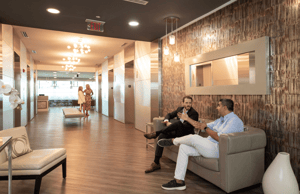Everything has some slight positive or negative effect on productivity. From the time of day and the weather to the amount of chatter in the next cubicle or stress at home - there are many variables that go into intentionally creating a productive space or accidentally creating an unproductive space. However, businesses expect employees to be productive, so it's important to address all factors that contribute to a productive or unproductive workforce. That starts with a deeper understanding of which barriers are getting in the way in your current office space. Once understood, then intentional, measurable changes can be made to increase healthy and focused work.
Identify the Biggest Productivity Barriers in Your Office
It is difficult to solve a problem when you don't know exactly what it is. If your employees' productivity is trending downward or you hear team members say it's hard to stay focused, start investigating the underlying causes. You can use a couple of different strategies for this. The first and simplest is to reflect on what about your company office space makes you feel unproductive. Is there clutter? Is it crowded? Is there a certain time of time when focus dwindles?
For an even clearer and more comprehensive understanding of the problem, ask your team directly for their own experiences. Some common productivity obstacles in the work environment include:
- Uncontrolled noise levels from nearby conversations, music, or traffic noise. For some, even the buzzing of the lights may be disruptive, and general work chatter (even when it's quiet) can interfere with client calls.
- Uncomfortable workspaces: Hard chairs, low monitors, and a constant feeling of surveillance are all common problems in open office spaces.
- No breaks: Conventional office spaces don't invite short breaks for refocusing. Science shows that small breaks for walking, meditating, or simply changing location actually help our brains learn and increase focus.
Once you know what's getting in the way of productivity, you can start investing in solutions. Look at some common problems below and the easy fixes you can make.
Offer Spaces with Different Volumes
Establish different volume levels in different areas of your office space. Today, teams and departments don't necessarily need to work sitting next to each other. Instead, create open areas where chatting and talking are welcome, quiet spaces for focused work, and private offices for sensitive phone calls and private one-on-ones. Of course, having a policy that allows earbuds will also help.
Put More Desks in "Power Positions"
Feng shui is becoming popular again, and it's more than just a style choice. Placing your desk in the power position—facing the doorway, not having your back to an open space—makes a lot of people feel more comfortable. This ensures your team will not feel they're being watched constantly, and they will feel more in control of their environment.
Unfortunately, there's a logistical difficulty for putting everyone in this one position. So, you may need to cleverly arrange the cubicle walls and internal walls to make layouts that give everyone this feeling of control.
Let Employees Decide When the Day Starts and When They Need Breaks
The environment is about more than just the physical environment—it's also about time. Some of your staff work best in the early morning hours, while others are their most creative at night. Still others will be parents who need to adhere to a tight school schedule, and some will alternate between deep work intervals and shorter cycles of productivity, mixed with walking breaks.
One of the best ways to build a more productive environment is to accommodate your team's schedules as best as you can. Be transparent about essential hours that need to be covered and try adopting a results-based approach for non-essential hours.
Give Employees Tools to Modify Their Online Status
The digital status your team can display on Slack, their calendars, and any other communication tools will shape their work experiences. Make sure they can fully customize their status to be busy, open to direct messaging, in meetings, driving, and anything in between. Setting a healthy culture around direct messaging and online statuses gives employees more room to not constantly feel like they must stop work for emails, direct messages, and calls.
Find Coworking Spaces That Help Employees Choose Their Own Productive Spaces
Trying to do all of this in a conventional office space is incredibly difficult—that's why more and more organizations are moving to flexible spaces like Quest Workspaces. Getting a membership to hospitality-driven coworking spaces and hybrid work environments opens the door for more flexible work environments that facilitate different working styles, different schedules, and different needs, all while being more cost-effective than a traditional office. Contact us today to learn more about how our spaces can increase your team's productivity, or tour our Tampa, West Palm Beach, Boca Raton, Broward, Miami or New York City coworking spaces for yourself.


